At the beginning of the month I did a week long “water” fast meant to potentially reduce my life-long cancer risk. The methodology I was trying for was described in this kick-off post . With now two weeks of data for the period afterward I can fully document how successfully the fast went and what the effects were on my immediately measurable and tracked biomarkers. What is impossible to do is determine if this is actually doing anything to reduce my cancer risk. That’s something that will at best be determined over time. It’s anti-climactic I know. The “results” question for me in the immediate term is if I’ve crafted a fasting protocol that works for me with minimal side effects.
The usual disclaimer applies: I am not a doctor, trainer, dietitian, nutritionist, or any other expert in any related field. I’m talking about my amateur and anecdotal experiences here and none of this should replace expert medical advice.
Goals for Version 2.0
As I wrote in the kick off post the two things I was trying to achieve with the modifications was to ensure that the transition in and out of the diet was a bit smoother and to make sure that I wasn’t losing too much muscle during the fast.
Although I had no major issues with my first try of Version 1.0 last year I did end up waiting too long to finish up my soup on the last day. This 13 cup vat of soup that is the sole food for the entry and exit days is a lot of food but especially important on exit day since that is after three days of not eating. That meant that I really had to force myself to finish it properly. To fix that I tweaked it to include eating a lot more soup earlier in the day. I also explicitly listed the B vitamins in the lead up to the core calorie free days and at the beginning of that I take to emphasize the importance of avoiding B1 deficiencies, among other issues, when re-introducing food on the exit day.
In Version 1.0 of the fast that I did in July I also lost a lot of weight and half of that weight loss was muscle loss. There were some potential confounding factors there. I was in the middle of a longer fat loss program when I did the program. The body fat data itself is very noisy as well. As I wrote at the time despite trying to use two week averages before/after to get around noise problems with the data and the confounding factors it was concerning that I had lost that much muscle over such a short period of time. This time around I am not in a fat loss mode around the fast. I also increased the amount of exercise I am doing on the fast to try to avoid the muscle loss. How did things flesh out for that?
The extra workout data for this was to make sure that I was doing a 30 minute easy-to-moderate cardio session on the Peloton each morning. That is paired with this 10 minute bodyweight training program, also on Peloton. I experimented with this before and for me this seemed to provide enough daily stimulation to feel my muscles working but not so much that doing it, especially day after day, would cause muscle breakdown.
Performance Summary
Overall this version of the fast went off with even less of a hitch than the Version 1.0 back in July. The one big screw-up was planning one of these days being a travel day. It was unfortunately unavoidable. It turned out to be an especially sucky travel day on top of that. But beyond that the fast was pretty much unremarkable. I felt less fatigue, loopiness, and food obsession than I did in the first one. Is that because I allowed myself to drink diet sodas again on this one so I got some flavor variety? Is it because my body was in a more fined tuned state when I started? Is it because I wasn’t in the middle of a longer term fat loss program leading up to it? Was it the extra exercises I added? Any combination of those are possibilities which I probably won’t determine until I do another one of these.
Below are the day by day diaries of how things went.
Fast Day 1 (Transition In)
This day was pretty easy, as expected. I ate more than enough food with the giant vat of soup I had for the day. The transition in day is supposed to have the same soup as the transition out day but with an addition of 1-2 ounces of nuts. I forgot to eat the nuts until just before bed. Rather than start the timer on the fast later I just skipped it. On the opposite side of eating stuff that wasn’t planned, I did end up eating two sweet bell peppers in the afternoon since they would have gone to waste due to my planned travel. Things were pretty dialed in despite those deviations. The day was a bit stressful because there were a lot of things going on which I think contributed to my blood pressure increasing throughout the day but overall it went off without a hitch. Workout wise I did the body weight training above plus this moderate to high intensity 30 minute bike ride .
Fasting Day 2 (Core Fast Day)
I woke up feeling a bit hung over and a bit tired. By “a bit hung over” I meant feeling a little parched, a very slight headache, and a bit groggier than usual. Honestly, I can get these sort of feelings if I’ve done something as eaten too much salt the previous day or had a not great sleep over the night. Yeah, I’m kind of a baby about that.
I rolled into my morning workout which was the body weight training above plus this 30 minute easy recovery ride . That actually wired me up pretty well and got all the “hang over feeling” and tiredness out of the way. Usually for these fast days I try to stay home with only light work I have the choice to opt out of if I choose to. That way if I’m just feeling tired or unmotivated I can take a nap, veg out on the couch, etc. On this day however I had air travel. What was worse is that it was air travel on a day where all national air traffic, including where I was, was being interrupted by a major storm system.
So what was going to be five hours of travel door to door turned into me being stuck in my first airport for almost 12 hours and the whole trip lasting into the wee hours of the next morning. Those delays weren’t one big delay but lots of delays, plane changes, airline changes, hurry up and wait to hurry up and wait again, etc. Lots of first world problems I know but my coping mechanism, for better or worse, is eating. Usually that means indulging in some junk food. The problem of course being that I am not supposed to eat anything with calories at all. I stuck with it the whole time, tried to do some additional Vipassana meditations to get through it without getting into a sour mood. I was only partially successful at avoiding the sour mood in the end but I did better than I was afraid I would without my junk food emotional crutches. I definitely jacked my caffeine levels way up as well. Ultimately I made it safe and sound without diverging from my diet plan.
Fasting Day 3 (Core Fast Day)
I definitely felt a bit more hung over than the previous day but not eggregiously so. I was equally tired though. I didn’t get to bed until after 02:00 and asleep some time before 03:00. Working with 6.5 hours of not great sleep all of the above wakeup feelings is understandable. I definitely was feeling a bit more spaced out in the morning as well, but all my vitals looked good. After my workout, the usual body weight training and a 20 minute Day of Persons with Disabilities Ride , I was feeling a bit better but not much. By afternoon however I was back to feeling totally normal again. I even managed to run out to the store to buy the materials to make the soup on the exit day. Any sense of loopiness, fatigue, etc. were gone. When I realized that I almost had a euphoric feeling about it. The loopiness did start coming back again late in the evening before bed but, again, nothing especially dramatic.
Fasting Day 4 (Core Fast Day)
I again woke up feeling slightly hung over, but more like on Day 2 than on Day 3. Even though I only got six hours of sleep rather than my usual seven for the second day in a row I had no tiredness at all. I felt the strongest I have felt yet out of all the fast days when doing my body weight training, although the heart rate during the exercise does seem to be creeping up each day. I was back to doing a 30 minute ride but again a nice easy low impact ride . By early afternoon I hadn’t experienced any of the foggieness/loopiness I had on previous days, which was a surprise. My energy levels were as solid as they had been on Day 1. I did end up taking a nap mid-afternoon to help make up for the lack of sleep the past two days. As the afternoon wore on I was getting some stomach grumbling, the first so far, and I did feel a general antipathy towards doing anything besides watching TV or YouTube. However any sense of loopiness, brain fog, low energy levels, etc. were non-existent through the end of the day.
Fasting Day 5 (Transition Out Day)
I’m not sure why but I didn’t sleep great. Maybe my brain was thinking ahead to eating again. I did wake up feeling a bit hung over again. This time it was about the same level as Day 3 but that quickly went away as I got the day started. I took my standard vitamins, including the aformentioned B vitamins, at 08:00 with my morning coffee. I then had my first real calories at 09:00 with a cup of sodium free bouillion mixed with 1/4 of an LMNT flavor free electrolytes pack and 1/2 a tablespoon of olive oil. I sipped it slowly to savor it a bit before getting started on making the soup I’d be eating for the rest of the day. I had my first up of the soup at 10:30 am. Once I was sure that went well I had another 1 cup at 11:15. All was going well so I then did my workout. That was the usual body weight exercise and another 30 minute low impact ride . I did not do as well as I did yesterday even with the two cups of soup and 1 cup of broth in me. I kind of expected that the two hours of eating something, even a little bit, would have caused an improvement that turned out not to be the case. I finished working out around 12:45 and ate a 2.5 cup portion of soup at 13:10 as a post-workout meal. As the day wore on I continued to gradually eat up the soup having 2 cups at 14:45, 1 cup at 16:00, 2 cups at 17:15, and the final 3 cup “dinner” portion at 18:00. All went off without a hitch this time.
Biometric Changes
As I wrote above, while the goal of this fast is for potential longer term cancer risk reduction not immediate biomarker changes, the reason for tracking these is to make sure everything stays in line throughout the fast and as an artifact of it. Losing tons of muscle mass is one big concern as is any change in cardiovascular fitness, etc. The Version 1.0 fast back in July did pretty well with everything except the body composition changes. This fast seems to have corrected most of it. There are still a couple limitations with the data I’m about to review.
The first big limitation is that the body composition is measured using the Withings Scale which uses a bioelectrical impedance analysis (BIA) method to measure body composition. This measurement type is very noisy. It can be heavily affected by levels of hydration, time of day it is taken, changes in skin surface conductivity (just out of the shower, just out of bed, etc). I also find it very sensitive to the volume of food in the digestive system, although not as much in recent years as with earlier versions of their algorithm. That obviously is going to have a huge impact during the fast. For me it was always 5-6 percentage points low in past years. Last summer I switched algorithms which made it closer but now 2-3 points high. Either way I find it useful for longer term trends but useless for absolute level estimation and in short term analysis. Literally from one day to another under normal circumstances it can change by two percentage points. Under fasting conditions the changes will be more dramatic.
The second limitation is on blood pressure measurements. I have a lot better data than before and this time I am using the same device, a Withings BPM Connect . While that was improved one thing I didn’t factor in was that the diameter of my arms were going to temporarily change as much as they did. Since I’m the only one using the cuff I usually just slip it on and off. However towards the end it seemed to be getting too loose. It wasn’t until the middle of the last day that I re-did the fit. This may or may not have contributed noise to the data.
With all that said, lets look at the data starting with overall weight:
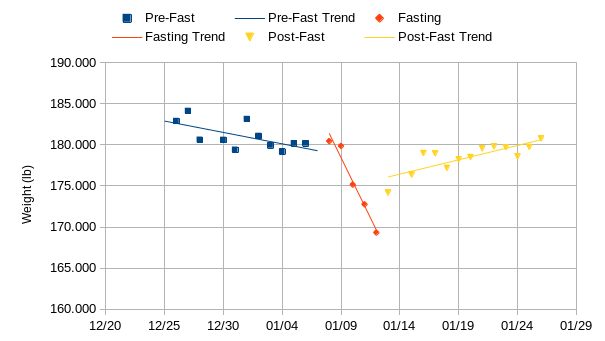
For the two weeks before there was a slight downward trend in weight with a big drop during the fast. For the two weeks after the fast there was a slight uptick in weight. These overall trends match the calorie balance estimates for the respective regions pretty well:
| Total Net Calories | Average Daily Net Calories | |
|---|---|---|
| Pre-Fast | -727 | -52 |
| Fast | -10,169 | -2,034 |
| Post-Fast | 5,060 | 361 |
The total net calories for the fast plus post-fast period was -5109 which if all fat would have corresponded with a fat loss of -1.46 pounds of fat. Looking at the body composition and fat/lean mass values we can see that it tracks pretty well with that.
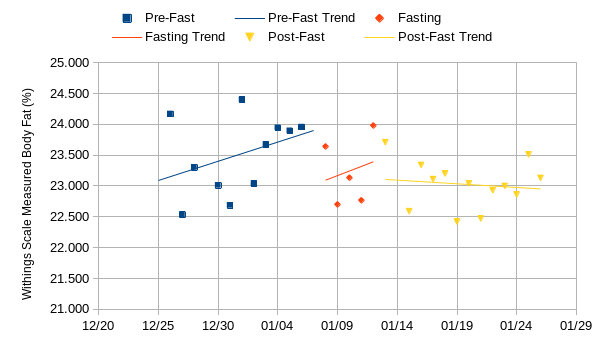
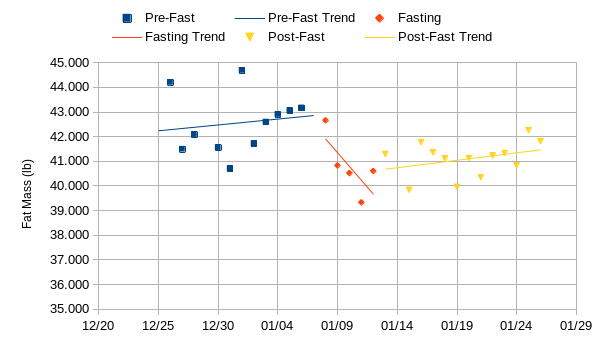
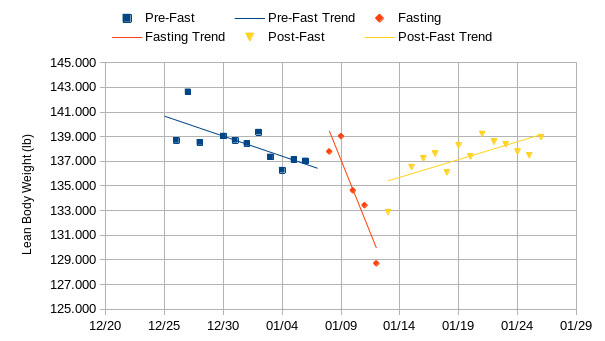
As stated previous body fat percentage as measured by the BIA system is very noisy so we have to look at potential overall trends. Overall the pre-fast average body fat percentage was 23.5%. The average one week out from the fast, to let any noise from the fasting period recovery itself to settle out, was 22.97%. Combine that with the changes in average weight, 181.034 pounds before and 179.118 pounds over the same post-fast period, and we get an approximate change in fat mass of -1.421 pounds and lean mass of -0.496 pounds. Considering the noise of the measurement data I think this matches the calorie balance estimates very well. This is in contrast to the same analysis from the July fasting period where there was a much more drastic weight change than calculated by the net calories balance.
More than just a question of the net calorie estimates matching the weight and composition changes, the big take away of this execution of the fast is that most of the weight change, about three quarters worth of it, was in fat mass loss not lean mass loss. Is this because of the extra working out, the fact that there was a mild calorie surplus per day after the fast, or a combination of the two? The fact that a couple of days after the fast the lean body mass levels were within the bounds of the levels from before the fast means that I think the additional exercises alone played a big part in it. This bodes well for being able to execute the fast without having dramatic negative effects on lean body masses.
Heart rate data throughout the three intervals were essentially unchanged:
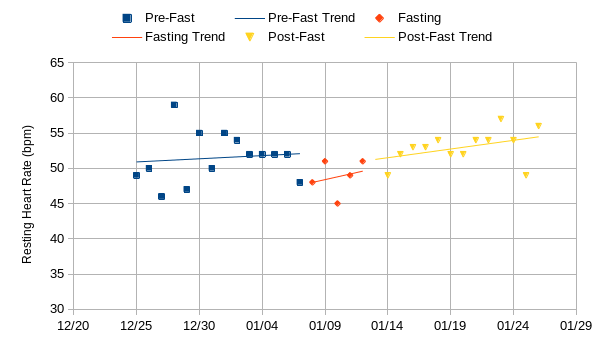
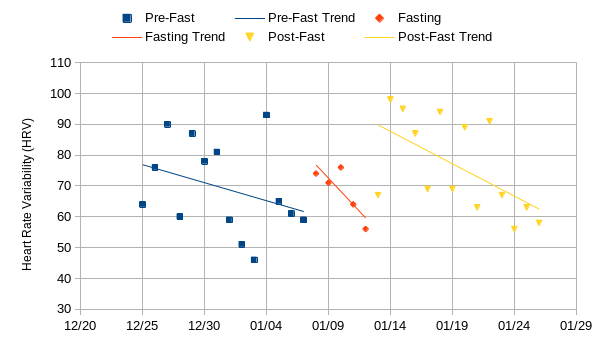
Resting Heart Rate (RHR) fluctuated from 51 bpm in the period before the fast, down to 48 bpm during the fast, and up to 53 bpm for the period after the fast. These variations are well within the natural variations I have over the past several months after getting my fitness dialed in. The Heart Rate Variability (HRV) values have similiarly small fluctuations with 69 ms before the fast, 68 ms during the fast, and 76 ms after the fast. Again these are within the normal fluctuations I usually see. During illnesses or overtraining the variations in these two parameters can be more exaggerated than this. Therefore the fact that these are within the normal variations range for me indicates that I didn’t overtax myself with the execution of this fast. The same is true of the blood pressure data:
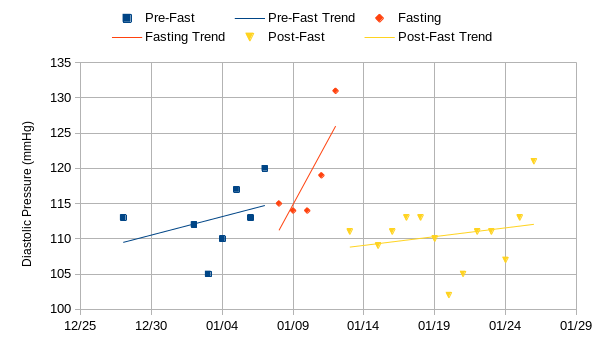
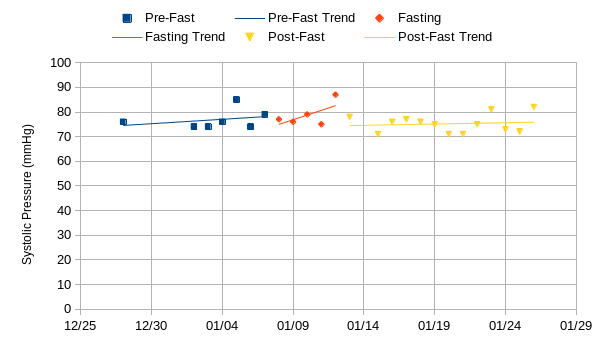
Again these variations in blood pressure are pretty much within the ranges that I often can see on a day to day basis. I am curious if the elevation towards the end of the fast was a byproduct of the less than ideal fitted cuff, as mentioned above. But even if it is not a measurement error it is high but on the high side of my normal ranges and snapped right back the next day. It is also a good sign that most of the measurements fall within normal blood pressure ranges. While I do have blood pressure data through out each of the days of the experiment and a few before to see how it can trend over the day the important one to review is for the final day, when refeeding issues are a potential problem:
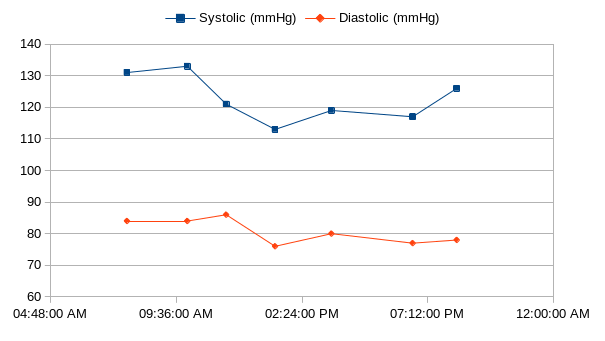
While the day starts off a bit on the high side it drops down into my normal range and stays there for the entire day. These slightly higher levels are witihn the range of where I was about a year ago before my fitness regiment and were also from before the cuff size was adjusted so may be anomalous.
Conclusions
Overall this new 2.0 version of the fasting protocol worked much better for me. I would have liked to have avoided even the ~0.5 pounds of muscle loss but that is kind of in the noise of my natural fluctuations anyway. Assuming I continue to have my workouts dialed by the time I do this fast again in another 6-12 months I may need to increase the amount of weight training I need to do each day. Other than that I think everything is pretty dialed in. The only other potential change I may add is to take blood glucose measurements at least once a day through the fast to see how that fluctuates over time.
The only real outstanding question is one of frequency. As I wrote in the kick-off post for the Version 1.0 of the fast in July , this is inspired by the fasting protocol research that Dr. Valter Longo has been doing. In his book “The Longevity Diet” where he talks about the frequency of doing the protocol for those that it is safe to try his “Fast Mimicking Diet” (FMD) (not the same as the above) he says it should be:
- Once a month for overweight to obese patiencse with at least two risk factors for diabetes, cancer, or cardiovascular or neurodegenerative disease
- Once every two motnhs for an average weight patient with at least two risk factors for diabetes, cancer, or cardiovascular or neurodegenerative disease
- Once every three months for average weight patients with at least one risk factor for diabetes, cancer, or cardiovascular disease
- Once every four months for healthy patiences with a normal diet who are not physically active
- Once every six months for healthy patients with an ideal diet who engage in regular physical activity.
At this time I think I am now in the last category, having gotten my body composition and early bad signs on some risk factors under control. According to that definition I should do at least a FMD every six months. If I were to extrapolate that to my own fasting protocol that means I should do one of these every six months as well. Because this is a bit more extreme than the FMD I’m toying with the idea of if I want to do one of my fasts once a year, at the beginning of the year, and an FMD in the middle of the year. That assumes that I keep everything very dialed in. I could, hypothetically, do one of my fasts twice a year as well. It’s just that while these fasts are easily doable they are definitely something I’d also rather do without. Why not just do the FMD each time then? I frankly have no good rationale for what mix of these would be best or if there is any difference at all.
It would be great to have something to tell if either this or the FMD protocol has any actual effect on my lifelong cancer risk in the same way it’d be great if my other lifestyle and diet changes had effects on that and any other illnesses of aging. So much of this is just unknowable. Keeping my exercise, lifestyle, and diet more dialed in over time and adding one of these fasts once a year is the bare minimum I can think of to do what I can to reduce my chances of getting cancer or these other illnesses. For my particular body/case even if it has zero effect on my lifelong cancer risk the risks and costs of the fast itself are so small that I think it is still worth doing.




 2024-01-29
in
2024-01-29
in

 18 min read
18 min read